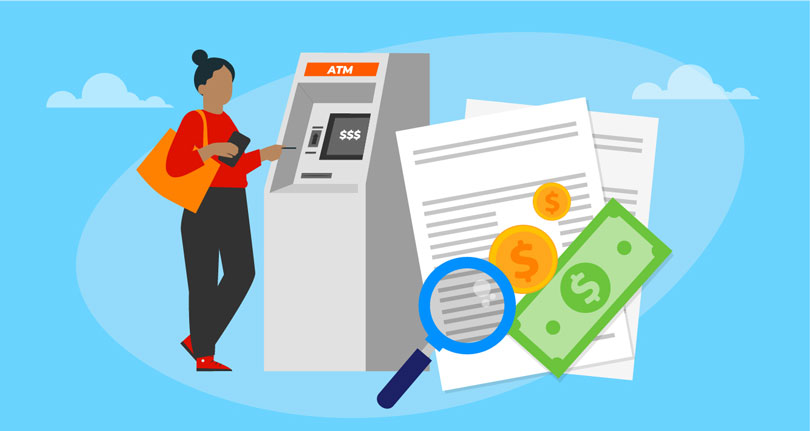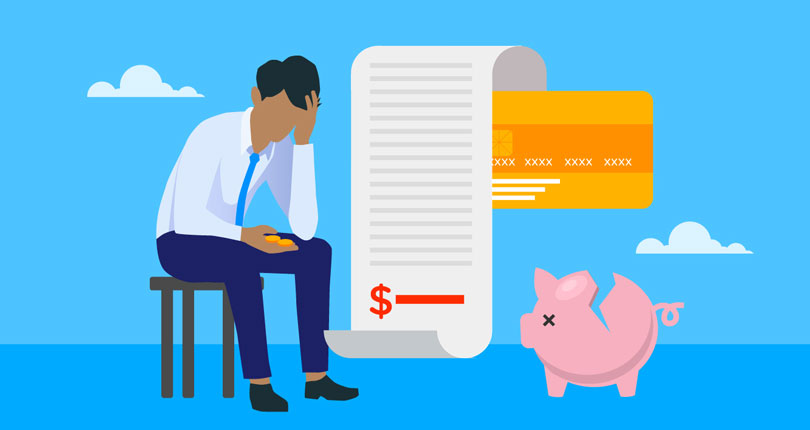History of Banking Fees and Charges in America
Banks often charge fees to their customers for a number of reasons when using their accounts. Let’s look at how banking fees and charges have changed over time, and why banks charge their customers to use different services.
Key Statistics
- The average monthly fee for a checking account in the U.S. is $10.77, ranging from $0 to $15, and the average minimum balance to waive this fee is $950.
- The average direct deposit to waive the monthly checking account fee is $541.67, ranging from $0 to $1,000.
- TD Convenience Checking has the highest monthly account fee at $15, however their minimum balance is one of the lowest at $100.
- Capital One’s 360 Checking® Account has the lowest cost with no monthly account fee.
- The minimum balance on interest checking accounts has increased by 154.8% between 2010 and 2021.
- The average overdraft charge is $33.58, with Capital One having the lowest at $0 and M&T Bank having the highest at $38.50.
What are banking fees?
Banking fees are any charges that banks and other financial institutions impose on their customers for setting up accounts, account maintenance, and withdrawals or transfers.
These fees might be charged once or continuously depending on the type of fee and the type of account you have. They can include ATM fees, late payment charges, non-sufficient funds fees, and many other charges.
A survey of 1,114 adults on behalf of Self Financial found that 46% of Americans believe the way we bank needs to change, but how have these banking fees changed over time?
Different types of banking fees
The types of banking fees you might have to pay will vary depending on the bank, the account, and how you use the account. Here are some of the most common banking fees and how they work. [1] Banking Fees and Charges Definitions https://www.investopedia.com/terms/b/bank-fees.asp
- Minimum account balance fees - With some banks, you’ll be required to keep a minimum balance in your account, the average across the top 10 banks being $950, but ranging from $0 to $1,500 [2] Checking Account Fees at the Top U.S. Banks https://www.mybanktracker.com/news/checking-account-fee-comparison-top-10-us-banks and if your balance drops below this you’ll have to pay a fee at the end of the month.
- ATM fees - These can be charged if you use an ATM that isn’t within your bank’s network. Usually, this charge will be taken at the time of the withdrawal. Individual ATMs can also have their own fees, so it’s important to be aware of this when making withdrawals.
- Transfer and withdrawal fees - A lot of bank accounts allow you to make a certain amount of transfers and withdrawals each month, but if you go over this you might be charged a service fee.
- Non-sufficient funds (NSF) fees - If you don’t have enough money in your account to cover a transaction you’re trying to make, the bank can charge you an NSF fee.
- Late payment fees - If you miss a payment on your credit card, you will usually be charged late fees, so try to make sure you’re paying things on time.
ATM fees and charges
If you need to get cash from an ATM while you’re out and about, it could cost you depending on which ATM you use. If you use an ATM that is within your own bank’s network, you usually won’t be charged an additional fee. However, banks charge non-customers between $2.00 and $3.00 to make a withdrawal from an ATM. Some ATMs also have separate charges which will be identified when you are withdrawing money, so it’s important to be aware of this as well.
Let’s learn more about the non-network and international ATM fees from some of the top U.S. banks.
All of the banks analyzed charge at least $2.00 for a non-network withdrawal, and at least $2.00 for an international withdrawal, although some international fees are charged as a percentage of the withdrawal amount.
Of the banks that do charge some ATM fees, Capital One and Frost Bank’s are the cheapest at $2.00 for a non-network withdrawal. Capital One charges $2.00 plus 3% for a non-network international withdrawal. Many of the other banks charge the highest rate of $3.00 for a non-network withdrawal, but Santander charges the most for a non-network international withdrawal at $6.00.
| Bank |
Non-Network ATM Withdrawal Fee |
Non-Network International ATM Withdrawal* |
| Bank of America |
$2.50 |
$5.00 |
| Capital One |
$2.00 |
$2.00 plus 3% |
| Chase |
$3.00 |
$5.00 |
| Citi |
$2.50 |
N/A |
| First Horizon Bank |
$3.00 |
$3.00 |
| Comerica Bank |
$2.00 |
$5.00 |
| Fifth Third Bank |
$3.00 |
$5.00 |
| HSBC Bank |
Fee is set by machine operator |
Fee is set by machine operator |
| KeyBank |
$3.00 |
$5.00 |
| PNC Bank |
$3.00 |
$5.00 |
| Regions Bank |
$3.00 |
$5.00 |
| Santander |
$3.00 |
$6.00 |
| TD Bank |
$3.00 |
3% |
| US Bank |
$2.50 |
$2.50 |
| Union Bank |
Fee is set by machine operator |
Fee is set by machine operator |
| Wells Fargo |
Fee is set by machine operator |
$5.00 |
| Huntington National Bank |
$3.00 |
3% |
| Bank of the West |
$3.00 |
2% |
| City National Bank |
$2.50 |
3% |
| Frost Bank |
$2.00 |
Fee is set by machine operator |
| Associated Bank |
$3.00 |
3% |
Source [3] ATM Fees List https://www.gobankingrates.com/banking/banks/atm-fees-list/
*Some banks may charge an additional fee if your ATM withdrawal is in a foreign country or foreign currency. Information is correct as of February 2023.
Checking account fees from different banks
Many of the top U.S. banks charge fees for a basic checking account, depending on your balance and how much you deposit. Below we can see the monthly fees from some of the most popular bank accounts, and the balances and deposits you’d need to avoid these fees.
Some banks will accept either the minimum balance or the minimum direct deposit to waive the fee, and some will accept a combined average balance across multiple eligible accounts.
| Account |
Monthly Fee |
Minimum Balance to Waive Fee |
Direct Deposit Amount to Waive Fee |
| Chase Total Checking |
$12 |
$1,500 |
$500 (total) |
| Bank of America Advantage Plus |
$12 |
$1,500 |
$250 (single) |
| Wells Fargo Everyday Checking |
$10 |
$500 |
$500 (total) |
| Citibank Basic Banking Account |
$12 |
$1,500 |
Any amount + one bill payment |
| U.S. Bank Smartly Checking |
$6.95 |
$1,500 |
$1,000 (total) |
| PNC Bank Virtual Wallet® Account |
$7 |
$500 |
$500 (total) |
| Truist One Checking |
$12 |
$500 |
$500 (total) |
| TD Convenience Checking |
$15 |
$100 |
None |
| Capital One 360 Checking® Account |
None |
None |
None |
| Citizens One Deposit Checking |
$9.99 |
None |
Any amount |
| AVERAGE |
$10.77 |
$950 |
$541.67 |
Source [2] Checking Account Fees at the Top U.S. Banks https://www.mybanktracker.com/news/checking-account-fee-comparison-top-10-us-banks
The information in this table is correct as of March 2023 and is subject to change.
Which bank charges the highest checking account fees?
Of the top banks listed above, TD Convenience Checking has the highest monthly account fee at $15, however they require the one of the lowest minimum balances at just $100 to avoid this fee. Second to this Bank of America, Chase Total Checking, Citibank, and Trust One Checking all charge a $12 monthly fee, but Trust One Checking requires the lowest minimum balance to waive the fee at $500.
Which bank charges the lowest fees?
The Capital One 360 Checking® Account charges no monthly fee with no minimum balance or minimum direct deposit, making this one definitely the lowest in terms of basic checking accounts.
Other banks that charge lower monthly fees are Citizens One and U.S. Bank. Citizens One charges $9.99 per month but has no minimum balance to waive this fee but it can be waived with a direct deposit of any amount. U.S. Bank charges $6.95 per month, but has a $1,500 minimum balance to waive the fee.
Change in banking fees over time
The average banking fees across the U.S. have changed over time, let’s take a look at some of the fees below and how they have changed since 2010.
Change in ATM and overdraft fees
The average person uses an ATM 3.8 times a month to withdraw cash, 2.5 times to deposit cash, and 2.2 times to deposit checks. [4] Demographics of ATM Use https://www.paymentsjournal.com/the-demographics-of-atm-use/
In 1998, the average total fee for using an ATM outside of your bank’s network was $1.97. This included both the fee for using the other ATM and the average ATM surcharge. In 2021, this total fee had increased to $4.59, a hike of 133%.
Average overdraft fees in 1998 were $21.57, but this figure has increased by 55.6% to $33.58 in 2021.
| Year |
Avg Total ATM Fees for Out-of-Network Withdrawal |
| 1998 |
$1.97 |
| 1999 |
$2.28 |
| 2000 |
$2.55 |
| 2001 |
$2.53 |
| 2002 |
$2.66 |
| 2003 |
$2.69 |
| 2004 |
$2.66 |
| 2005 |
$2.91 |
| 2006 |
$2.89 |
| 2007 |
$3.03 |
| 2008 |
$3.43 |
| 2009 |
$3.54 |
| 2010 |
$3.74 |
| 2011 |
$3.81 |
| 2012 |
$4.07 |
| 2013 |
$4.13 |
| 2014 |
$4.35 |
| 2015 |
$4.52 |
| 2016 |
$4.57 |
| 2017 |
$4.69 |
| 2018 |
$4.68 |
| 2019 |
$4.72 |
| 2020 |
$4.64 |
| 2021 |
$4.59 |
| % Change |
+133% |
| Year |
Avg Overdraft Fee |
| 1998 |
$21.57 |
| 1999 |
$22.62 |
| 2000 |
$23.74 |
| 2001 |
$24.70 |
| 2002 |
$25.30 |
| 2003 |
$25.80 |
| 2004 |
$25.81 |
| 2005 |
$26.90 |
| 2006 |
$27.40 |
| 2007 |
$28.23 |
| 2008 |
$28.95 |
| 2009 |
$29.58 |
| 2010 |
$30.47 |
| 2011 |
$30.83 |
| 2012 |
$31.26 |
| 2013 |
$32.18 |
| 2014 |
$32.74 |
| 2015 |
$33.07 |
| 2016 |
$33.04 |
| 2017 |
$33.38 |
| 2018 |
$33.23 |
| 2019 |
$33.36 |
| 2020 |
$33.47 |
| 2021 |
$33.58 |
| % Change |
55.6% |
Source: Bankrate’s yearly checking account surveys
Change in minimum account balance fees
The minimum balances required on interest and non-interest checking accounts in the U.S. have changed considerably in recent years.
From 2010 to 2021, the minimum balance required on an interest checking showed a 154.8% increase from $3,883 in 2010 to $9,896.81 in 2021. There has been some slight fluctuation in this figure with a slight dip between 2016 and 2018, but it has generally followed an upward trend.
The minimum balance required for non-interest checking accounts more than doubled overall in this time period with an increase of 103.2% from an average of $249.50 to $507. However, this figure hit its peak in 2012 at $723.02 and has gradually decreased since then.
| Year |
Min Balance on Interest Checking Accounts |
| 2010 |
$3,883 |
| 2011 |
$5,587 |
| 2012 |
$6,117.80 |
| 2013 |
- |
| 2014 |
- |
| 2015 |
- |
| 2016 |
$7,037 |
| 2017 |
$6,485 |
| 2018 |
$6,319 |
| 2019 |
$7,123 |
| 2020 |
$7,550.42 |
| 2021 |
$9,896.81 |
| % Change |
+154.8% |
| Year |
Min Balance on Non-Interest Checking Accounts |
| 2010 |
$249.50 |
| 2011 |
$587.82 |
| 2012 |
$723.02 |
| 2013 |
- |
| 2014 |
- |
| 2015 |
- |
| 2016 |
$670 |
| 2017 |
$668 |
| 2018 |
$631 |
| 2019 |
$622 |
| 2020 |
$594 |
| 2021 |
$507 |
| % Change |
+103.2 |
Source [5] Bankrate Yearly Checking Account Survey https://www.bankrate.com/banking/checking/checking-account-survey/
Total annual banking fees
So how much would all of these fees add up to today if someone paid the average monthly fee, went into their overdraft, and always used out-of-network ATMs?
Each month this would amount to $82.18 in fees.
| Fee Type |
Times per month |
Avg Monthly Charge |
Avg Annual Charge |
| Monthly Account Fee |
1 |
$9.60 |
$115.20 |
| ATM Use Out of Network |
8.5 |
$39.00 |
$468.00 |
| Overdraft |
1 |
$33.58 |
$402.96 |
| Total |
|
$82.18 |
$986.16 |
Source [4] Demographics of ATM Use https://www.paymentsjournal.com/the-demographics-of-atm-use/
How to avoid banking fees
With most banks, you’ll be able to avoid some or all of the fees associated with your account by taking a few steps.
- Keep up the minimum balance - Most of the banks we’ve discussed will waive the monthly account fee as long as you keep a minimum balance. This balance will vary depending on your bank and account type so it’s best to check with your own bank.
- Stay out of your overdraft - Going into your overdraft, also known as having non-sufficient funds (NSF) in your account can incur a fee, with the average being $33.58, and some as high as $38.50. Be aware of your spending and make sure you have sufficient funds in your account to avoid this charge.
- Use ATMs in your bank’s network - Try to use ATMs owned by or connected to your bank when possible. Sometimes you might have no option but to use an out-of-network ATM, but this can cost an average fee of $1.51 to use the machine and a total of $4.59 with a surcharge added. The highest ATM fee is $6 from Santander if you use a non-network ATM for an international withdrawal.
- Keep multiple accounts at the same bank - Many banks offer free services if you have more than one account with them, so consider keeping your checking account and savings account at one bank.
Sources






